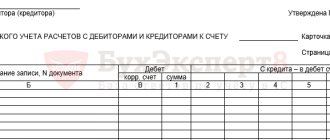The concept of synthetic and analytical accounts
In accounting, the economic life of enterprises and individual entrepreneurs is reflected in certain accounts regulated by the order of the Ministry of Finance of the Russian Federation “On approval of the Chart of Accounts for accounting of financial and economic activities of organizations and Instructions for its application” dated October 31, 2000 No. 94n.
Account entries reflecting the facts of business activities are made using the double entry method. In practice, this means simultaneous entry of an identical amount into the debit of one account and the credit of another. Basic accounting accounts are called synthetic. Synthetic accounts are accounts that contain generalized data on the business activities, property of the organization, as well as on the sources of property, collected according to certain characteristics. Synthetic accounting accounts have the ability to be divided into second-order subaccounts intended for detailing the account.
IMPORTANT! Accounting in synthetic accounts is displayed exclusively in monetary terms.
Analytical accounts are intended for greater detail and analytical assessment of the economic state of the organization. Accounting for this type of account is called analytical.
Analytical accounts are accounts of the third, fourth... order, which display in detail the cost and quantitative indicators of accounting.
IMPORTANT! The evaluation of operations in analytical accounting is carried out in monetary and quantitative terms.
Based on the definition of synthetic and analytical accounting, we can say that analytical accounting is an additional decoding in detail to synthetic accounting.
about what analytical indicators synthetic accounts should have according to the chart of accounts and instructions for its use here.
Analytical accounting
Analytical accounting involves detailed accounting on personal and analytical accounts. It allows you to obtain detailed information about the company’s property, its main obligations, as well as about the activities carried out. transactions within each individual account.
Analytical accounting accounts are accounts used specifically to detail information about the presence and movement of a company’s own assets, as well as the sources of their formation. They are opened in addition to synthetic accounts.
The company can determine the specification of indicators independently, guided by specific criteria in obtaining data for timely management. When establishing the procedure for maintaining analytical accounting, you need to determine for which accounts subaccounts will be opened and how many accounting levels there will be.
The choice depends on several factors:
- Tax legislation requirements;
- The need to generate and submit statistical reports;
- Requirements for accounting reports;
- The need for administrative accounting, as well as analysis for the effective management of accounts payable and receivable.
The procedure for the formation of synthetic and analytical accounting
According to the Chart of Accounts, there are a number of accounts for which it is possible to open subaccounts. Subaccounting, by its purpose, is an additional link between analytical and synthetic accounting. The subaccount, in turn, combines several analytical accounts. Grouped analytical accounting is maintained within one synthetic account, including within sub-accounts.
In practice it looks like this.
Consider account 41 “Goods”. According to the Chart of Accounts, it is divided into the following sub-accounts:
- 41.01—goods in the organization’s warehouses;
- 41.02 - goods in retail trade;
- 41.03 - containers under the goods and empty;
- 41.04 - purchased products.
Subsequently, within each sub-account there is a breakdown of analytical accounts, for example:
- 41.04 “Purchased items” - accounting subaccount;
- Cotton fabric, chintz, flannel - analytical account.
Thus, the analytical account in this case will be the characteristics and designation of the type of property. Further, its characteristics can be deepened by other parameters, for example, by color or width of the canvas.
An example of analytical accounting for account 10 “Materials”, subaccount 10-3 “Fuel” from ConsultantPlus Vostok LLC has six cars: two of them are fueled with AI-92 gasoline, two with AI-95 gasoline and two with diesel fuel . Fuel accounting is kept on account 10 “Materials”, subaccount 10-3 “Fuel”. For intermediate grouping of data on fuel in vehicle tanks by type, second-order subaccounts are used: 10-3-1 “Gasoline” and 10-3-2 “Diesel fuel”. Analytical accounting of fuel is carried out in the balance sheet according to fuel grades and storage locations, which are considered to be vehicles. For August, the accountant filled out the balance sheet based on data from primary documents - waybills and advance reports of drivers with attached gas station receipts. You can view the entire example in K+ by getting free trial access.
What is a subaccount
Subaccount is an intermediate link between analytical and synthetic accounts. It is used to account for objects of various types. This additional step will help group identical information into a second level of detail. For each group, analytical records are kept, in which the things of each group are called by their proper names. If this is not enough, they develop it in even more detail.
Sub-accounts can be maintained in both cost and physical units. Their purpose is clear in a simple diagram:
| Synthetic account | Subaccounts | Analytical accounts |
| 10 "Materials" | 10.1 Fuel | 10.1.1 Gasoline 10.1.2 Diesel fuel |
| 10.2 Containers and packaging materials | 10.2.1 Pallets 10.2.2 Cardboard |
Note: As a rule, a subaccount contains several analytical accounts, and a synthetic account may include several subaccounts. This accounting scheme is not mandatory if additional grouping is not necessary.
Mutual relationship between synthetic and analytical accounting
Facts indicating the relationship between analytical accounting and synthetic accounting:
- The basis for records in both types of accounting is the same document.
- Analytics is an additional detailed characteristic to synthetic accounting.
- The total amount of turnover for analytical accounts is equal to the total turnover for a synthetic account that combines detailed analytics.
For example, material accounting at a sewing enterprise can be organized as follows.
Synthetic accounting
| Check | Beginning balance (rub.) | Turnover (rub.) | Balance (rub.) | |
| Dt | Dt | CT | Dt | |
| 10.1 "Raw materials" | 18 490 | 7 500 | 17 670 | 8 320 |
Analytical accounting
| Check | Nomenclature | Unit change | From-beginning | Revolutions | S-to con | |||||
| Qty | Dt (rub.) | Qty | Dt (rub) | Qty | Kt (rub) | Qty | Dt (rub) | |||
| 10.1.1 Fabrics | Pog. m | 20 | 10 000 | 12 | 6 500 | 22 | 10 800 | 10 | 5 700 | |
| silk | linear m | 5 | 3 000 | 2 | 1 200 | 4 | 2 400 | 3 | 1 800 | |
| cotton | linear m. | 10 | 1 500 | 6 | 900 | 12 | 1 800 | 4 | 600 | |
| wool | linear m. | 5 | 5 500 | 4 | 4 400 | 6 | 6 600 | 3 | 3 300 | |
| 10.1.2 Fittings | PC. | 150 | 1140 | 170 | 900 | 250 | 1 620 | 70 | 420 | |
| buttons | PC. | 120 | 240 | 150 | 300 | 210 | 420 | 60 | 120 | |
| lightning | PC. | 30 | 900 | 20 | 600 | 40 | 1 200 | 10 | 300 | |
| 10.1.3 Sewing accessories | PC. | 14 | 7 350 | 2 | 100 | 10 | 5 250 | 6 | 2 200 | |
| scissors | PC. | 7 | 7 000 | 5 | 5 000 | 2 | 2 000 | |||
| Tape measure | PC. | 7 | 350 | 2 | 100 | 5 | 250 | 4 | 200 | |
Account 10 can correspond with different accounts, for example, accounts 20, 60, 76, 91, and even with account 94. Accounting account 94 is an account for accounting for shortages and losses.
Displaying synthetic and analytical accounting in the organization’s reporting
Maintaining accounting records by double-entrying accounts according to the approved working chart of accounts is the responsibility of the organization.
The turnover and results of synthetic accounting are reflected in the general ledger. The general ledger is the basis for the preparation of financial statements, including the balance sheet.
You can see an example of the General Ledger and other accounting registers in ConsultantPlus. Trial access to the system can be obtained for free.
Analytical accounting is reflected in a variety of accounting registers: cards on the movement of property, accumulative statements and other reporting documentation. Combining synthetic and analytical accounting in one accounting register is common.
Synthetic accounting
Synthetically, accounting is a type of accounting that provides generalized data about each item on the balance sheet, without specification. That is, synthetic accounting is usually understood as generalized information about the activities of an organization.
Each accountant is guided by a chart of accounts; it is uniform for each organization and is regulated by the legislation of the Russian Federation. The chart of accounts reflects synthetic and analytical accounts. So, synthetic accounts have two-digit numbers, there are ninety-nine of them in the chart of accounts, but not every organization uses them all. For some organizations, it is enough to reflect the necessary account data in their balance sheet.
There are the most common generalized accounting accounts, which are maintained in almost every enterprise. In these accounts, the accountant must reflect complete information of all available data.
Important!!! Thus, we can conclude that synthetic accounts at all enterprises are the same and have generalized information on a given account. This information must be reflected in the chart of accounts.
There are situations when generalized information is not enough to maintain records and control them. Then it is necessary to request detailed information for each account from the accounting employee. More detailed information on accounts is reflected in analytical accounting, that is, detailed accounting.
Monitoring the correctness of synthetic and analytical accounting
The main document for monitoring the correct display of accounting records is the balance sheet.
For more information on the procedure for generating turnover sheets, see the material “How to fill out a turnover sheet (form, sample)?” .
This accounting register is a grouping by accounting accounts, including subaccounts, indicating their names, total balances at the beginning of the period, turnover for the period (according to the assets and liabilities of the accounts), and the total amount as of a given date.
IMPORTANT! The turnover sheet can be compiled for any time period: both per day and per month, full and partial year. To form a balance sheet, data from the turnover sheet for the reporting period is taken.
The statement must meet the main principle of equality (the final balances of the debit and credit of the accounting account must be equal to each other).
IMPORTANT! The principle of equality is regulated and characterized by the structure of financial statements (balance sheet). The debit of the accounts is responsible for the property of the business entity; the credit of the accounts reflects the sources of formation of the property. Failure to comply with equality clearly indicates a violation and incorrect reflection of the facts of the organization’s activities in accounting.
For more details on the details of drawing up a balance sheet, see the article “Filling out Form 1 of the balance sheet (sample).”
Turnover sheets for analytical accounting can take different forms. These include a variety of statements - storekeepers' reports, commodity reports, and other accounting registers. The procedure and timing for the generation of statements are regulated by the established document flow of the organization and legislative norms. Most often, for the preparation of analytical reports, this is a calendar month.
How to open a synthetic account
When saying the phrase “Open a synthetic account”, they mean filling out the relevant accounting documents, because This type of account is fundamentally different from bank accounts due to its purpose. Synthetic accounts are created to account for property, various business processes and obligations in a generalized form in monetary terms in accounting. They serve to analyze economic activities and are the source of the formation of the enterprise’s balance sheet.
1
For convenience, all existing accounts are classified according to certain criteria. This classification is nationwide and is called the “Chart of Accounts,” which acts as a scheme for registering and systematizing the actions taken in the economic activities of an enterprise in accounting. Synthetic accounts are first-order accounts, which, if necessary, are refined by sub-accounts (second-order accounts). Here.
2
For each account, a card is maintained, which indicates the code and name of the account, balances at the beginning of the period, business transactions carried out for the period and results at the end of the period. Because accounts can be passive, active or active-passive, there are some features in filling out documents for each type of account. In active accounts, the debit of the account reflects the opening and closing balances, which is equal to the sum of the opening balance and the debit turnover minus the credit turnover.
3
In passive accounts, the opening and closing balances are reflected on the loan; in this case, the ending balance is equal to the sum of the opening balance and credit turnover minus the debit turnover.
4
Active-passive accounts have their own filling features:
- in the “Initial balance” column the amount of receivables is indicated at the beginning of the period, and in the “Debit turnover total” - at the end of the period;
- turnover on a debit account – an increase in accounts receivable or a decrease in accounts payable;
- the initial loan balance reflects accounts payable at the beginning of the period, and the final balance at the end of the period;
- an increase in accounts payable or a decrease in accounts receivable is recorded in the account turnover in the “Credit” column.
5
Synthetic accounts are reflected in the balance sheet of the enterprise. The first statement is compiled when creating an enterprise and is zero. This type of accounting reporting is carried out continuously with a certain frequency: monthly, quarterly and/or annually. Preparation of the balance sheet:
- the first and second columns are the numbers and names of all accounts that have balances at the beginning of the period, first enter the active ones, then the passive ones;
- using the data from each account, reflect the corresponding amounts in the statement using the rules for calculating the final balance;
- in the last line “TOTAL” the results for all columns are summed up, and three equalities must be observed: the initial debit balance is equal to the initial credit balance, respectively, for turnover and final balances.
Balance sheet form on our website. We have an example of a completed balance sheet.
Document flow at an enterprise begins with primary accounting documents, on the basis of which statements of analytical accounting are created, in turn they are the basis for synthetic accounting.








